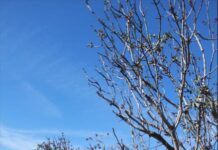
The duration and intensity of the fire season has increased due to increasing temperatures, earlier snowmelt, reduced fuel moisture and overgrown forests. The presence of smoke in the atmosphere as a result of wildfires can affect evapotranspiration (ET) and CO2 concentration in row crops and orchards, according to Kosana Suvočarev, a cooperative extension specialist in biometeorology at UC Davis. However, it is unclear whether the effect of smoke on pistachio orchards is negative overall.
To know whether or not smoke is affecting ET in pistachio orchards, levels of photosynthetically active radiation (PAR) need to be taken and compared against the threshold for pistachio. In a 2020 study lead by cooperative extension specialist Giulia Marino, Marino and other researchers found that 800 PPFD is about the optimum threshold for PAR necessary for development of all three pistachio growth stages. Past this value, increases in photosynthetic activity in the tree are substantially less.
During the 2021 Pistachio Day virtual conference, Suvočarev explained that important reductions in PAR received by plants can occur during smoky days. However, she cited a 2020 study of different crops conducted during wildfire season between August and October in Davis and Corning, Calif. where she and researchers found that once smoke entered the area and lingered, PAR values dropped, but not enough to negatively affect pistachio orchards in the area.
“While pistachio orchards weren’t the only crop being assessed for negative effects in the area, only one day during the study showed a critical drop in PAR below the 800 PPFD threshold required for pistachio,” Suvočarev said.
In fact, a study published in 2018 by Kyle Hemes, a Postdoctoral Fellow at the Stanford Woods Institute for the Environment, noted that taller, higher plant canopies actually benefit from smoke due to diffuse refraction of PAR.
“We have much more scatter [of light particles],” Suvočarev said. “Some researchers say that this scatter, as it bounces through different particles, can reach some leaves that are normally shaded.”
As for ET and CO2 concentration, the effects are still being studied in pistachio. In 2020 between August and November in Tehama County almond orchards, CO2 concentration (ppm) was measured directly and was observed to increase during smoky days, leading to changes in ET.
“There is some effect when we have direct measurements of ET. While we didn’t have direct measurements in pistachio, we do expect ET to decrease.”
UCCE Farm Advisor Emeritus Bob Beede commented that there is a reduction in ET for pistachio of 15% to 20% during smoky days depending on salinity as well as delayed maturity.
Decreased ET can become a problem in orchards and cause waterlogged soils if growers are irrigating often in the period where a last irrigation is needed, according to Suvočarev.
















